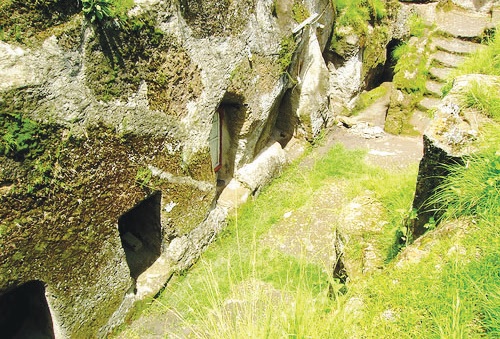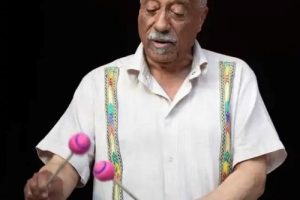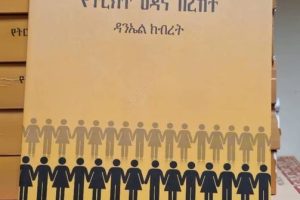
COMPILED BY BETHELEHEM BEDLU
Adadi Mariam Rock –hewn church, which is one of the few rock hewn churches in the southern part of Ethiopia, is located at the distance of 73Kms from the capital—Addis Ababa. According to oral history, Adadi Mariam, which is similar to Rock-hewn churches of Lalibela, was built by king Lalibela who reigned from 1181-1221.
The name ‘Adadi’ was given due to two reasons. One is derived from the name of a tree, known as elephant grass, which is up to one and half to three meter high, white and grew on the acme of the church. The name of the tree is “Anfar” in Amharic and “Adi’ Adi” in Oromiffa language.
Since the local people were Oromipha language speakers they used the term “Adi’ Adi”, which gradually becomes Adadi. Second, it is said that during the excavation of the church, the Oromo community of the area observed the white doves coming up and down and they said “Addi Naama” which means “that is white people” and associated them with angles.
There is a strong tradition about the coming of Lalibela to the region of Shewa and excavated Adadi Mariam rock-hewn church. This story is also found in the book known as Tefut in Gishen Debre Kerbie monastery and in Sodo Debre Ader (Mahder) church of Zuquala mount. The book of Tefut stated about the founding of the true cross and its coming from Jerusalem and stayed in Adadi Mariam for seven days.
Adadi Mariam rock hewn church is a type of rock-hewn cave church excavated in wards from a more or less vertical cliff. It is also partially separated from the main rock with various degrees of attachment to the rock.
According to Oral traditions, the establishment of Adadi Mariam church is related to the coming of one of the prominent saints of Ethiopian Orthodox Tewahido Church, Abune Gebre Menfes Qedus, from Egypt and a visit made by king Lalibela.
The saint is said to have founded the monastery of Mount Zuquala in Southern Shoa. It is said that the saint came to Ethiopia when king Lalibela completed the construction of churches at Roha.
The tradition added that before the journey of saint Gebre Menfes Qedus to southern Shoa, he stayed in Lasta with king Lalibela. Then he went to mount ziquala where his monastery is found.
After some years, king Lalibela went to receive blessing from Abune Gebre Menfes Qedus. While they were visiting the monastery together, Lalibela saw a tent in a light and saint Mary with her Baby in her arm on top of it and white doves coming up and down for missions from the monastery to the western direction which is the present location of Adadi Mariam rock-hewn church.
Then, king Lalibela suddenly went to establish the church on the area and started the work. It is said to be happened during the last quarter of 12th century and early 13th century. Finally he put the tabot of Saint Mary into the church and its consecration took place immediately.
It is also said that Lalibela did not finish the construction of the church and still the unfinished part of the church is observable. The excavation of this church is said to have been completed within three years.
The church has three entrances, from the east for priests, from north for men and from south for women. It also has ten doors and twenty four windows which signifies the Ten Commandments and twenty four heavenly priests respectively.
The population settled in and around Adadi Mariam is categorized under the Cushitic language family, i.e. Oromiffa language speakers. The setters are practicing mixed agriculture, both animal herding and cultivation. The agricultural practice is mainly depending on the rainy season.
The farming activities are done near to the church in which the outputs of the area are Teff, Wheat Maize, Barley from cereals and Beans and Chickpeas from pulses. This moderate climatic nature of the area is also suitable for the other agricultural products.
In Adadi Mariam rock-hewn church treasury house, there are various collection of spiritual books written on parchments in Geez language. From those various collections: the Holy Bible, New Testament, Miracles of Mary, the Faith of Fathers, liturgical books, Hymn books, prayer books are found.
Many of these manuscripts are with various illuminations (decorations), on their covers and inside the folio’s (pages). Each folio’s of the manuscript has two columns and written in red and black color.
Paintings of saints are also seen in Adadi Mariam church. The paintings on the walls of the church are appealing to the eyes. The one and the popular Saint Mary paintings are dominated the wall of the church.
There are also paintings of Saint Abune Gebre Menfes Qedus, birth of the Christ, Apostles at dinner, the Holy Trinity and the other church paintings on the walls of Adadi Mariam church.
In Adadi Mariam there is a stone which locally considered as sacred. It catches the attentions of the visitors because a person who can hold it in his shoulder is considered to be not sinner according to the legendary belief of the local people. The stone is dark brown and measures 43×43 centimeter.
Adadi Mariam rock-hewn church is the only still standing rock-hewn church built in the 13th Century and found in southern part of the country. However, it has faced several threats due to management problems.
In order to prevent further deterioration of the church, trenches and drainage systems should be cleaned as it minimizes the amount of infiltration the rock masses.
Moreover, in order to reduce the impact of rainfall, sunshine, and biological colonization, it is recommended to cut the ‘anfar ‘on the acme of the church. More importantly, the church has to be sheltered with the most possible care for the aesthetic look as well as conservation works should be done based on a well prepared and organized approach and multidisciplinary study has to be conducted.
The Ethiopian Herald February 26/2021





